8 Soda Brands To Stay Away From Right Now
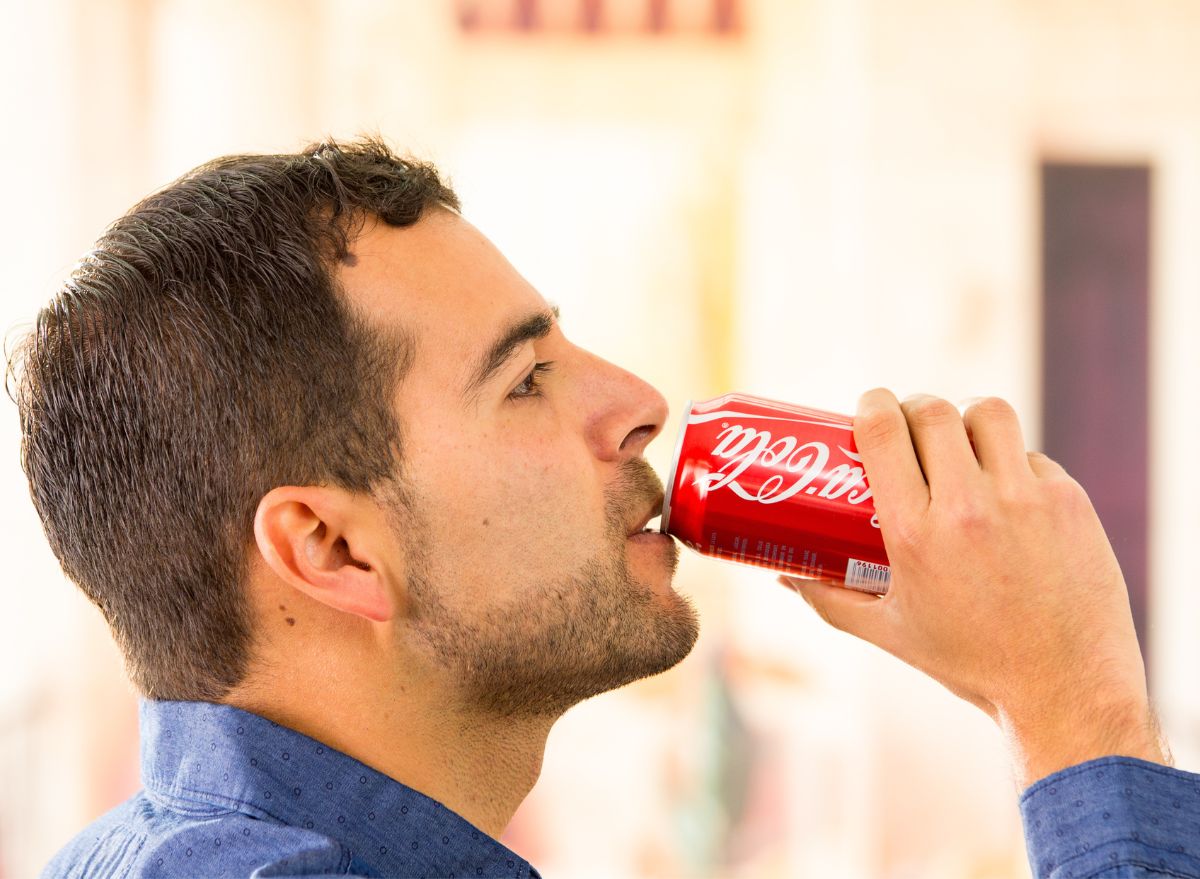
So, what’s popping in the soda industry? Soft drinks remain one of the most popular drink categories in America, making up almost 19% of beverage consumption across the country—second only to bottled water. And, according to the CDC, nearly 50% of adults drink at least one sugar-sweetened beverage like soda every day.
Top dogs Pepsi, Coca-Cola, and Keurig Dr. Pepper still rule the soda world with their notoriously extensive collections of brands and flavors. And, pop continues to dominate grocery stores, restaurants, and even major events like professional sports games. But, what’s most important to note, is that many soft drinks in the United States are still as unhealthy as ever—a problem which has been bubbling up and spilling over for quite some time.
“Soda is basically just water with added colors, flavors, sugars and sometimes caffeine, so as usual, we take perfect foods like water and turn them into liquid sugar bombs that can be quickly consumed without actually contributing anything with nutrients or health benefits whatsoever,” explains registered dietitian Laura Burak, MS, RD, founder of GetNaked Nutrition and author of Slimdown with Smoothies.
Burak also explains that drinking soda is typically synonymous with a more unhealthy lifestyle, and many people who drink these carbonated beverages are drinking them regularly and in large amounts. Megan Hilbert, a registered dietitian and nutritionist with Top Nutrition Coaching, agrees that portion control is one of the largest issues when it comes to soft drinks.
“In moderation, soda can be enjoyed especially with other meals that help slow down the intake of blood glucose, but when consumed often (even a couple of times a week) soda can impact our bodies ability to regulate blood sugar properly and lead to insulin resistance,” says Hilbert.
“It also can impact the health of our teeth since soda is a double whammy of high acid and high sugar, neither of which are good for enamel. Artificial sweeteners also aren’t much better since their impacts have been called into question and have been shown to negatively impact our gut health, increase sugar cravings, and even lead to weight gain in the long term.”
Besides sugar and artificial sweeteners, you should also look out for potentially harmful additives like phosphoric acid, sodium benzoate, and artificial dyes/coloring like Yellow 5 or Red 40 in your soda brands. Newer, reinvented sodas like the prebiotic soda Olipop or botanical-based Ghia Le Spritz aim to cut out these ingredients, but Burak is still not convinced. She admits she would still recommend just water or club soda with a splash of juice or fruit over anything else.
In terms of older, more classic sodas on the market, there are a handful which are particularly problematic. Read on to find out which make the list and should be avoided to protect your health.
Mountain Dew
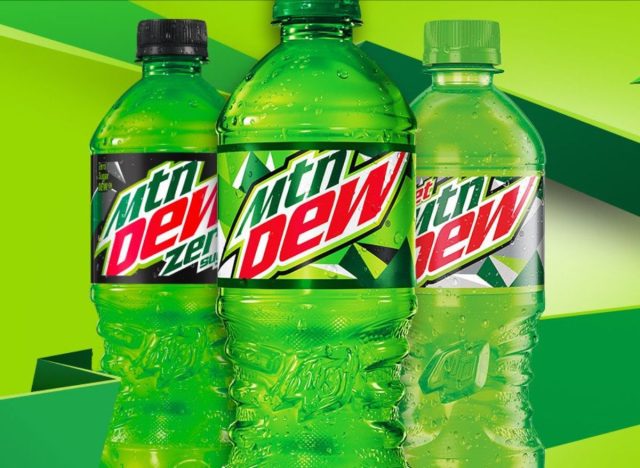
The toxic slime coloring of Mountain Dew alone makes it look like a substance that should only be handled by someone in a hazmat suit—and in reality, that might not be such a terrible idea.
The classic soda’s artificial hue is actually derived from something called Yellow 5 (or tartrazine) which is a synthetic food dye commonly found in processed foods in the U.S. Other countries have limited or even banned its use. Several studies have found that prolonged ingestion of the dye could trigger carcinogenesis—the formation of cancer. Plus, artificial colorings including Yellow 5 have been linked to hyperactivity and other behavioral changes in children.
What’s worse is that other Mountain Dew variations add even more questionable dyes into the mix. Take Code Red Mountain Dew for example. The jolting spinoff combines Red 40 and Blue 1 on top of Yellow 5.
Up until a few years ago, brominated vegetable oil (BVO) was also a main ingredient in the soft drink. BVO is another harmful additive which has been linked to various health concerns such as neurological issues due to the bromine it contains. While BVO has since popped off the Mountain Dew ingredients list, the drink is still chock full with plenty of other less-than-ideal ingredients that are sure to do more than just “tickle your innards” (per Mountain Dew’s slogan from the ’60s). Each 20-ounce bottle of the fizzy drink contains 290 calories, 77 grams of sugar, and 105 mg of sodium.
Last, but not least, have you heard of something called Mountain Dew Mouth? That’s the name dentists have given to the tooth decay, cavities, and other dental problems that can arise from drinking too much pop such as–you guessed it–Mountain Dew.
With all this in mind, it sounds like it’s best to avoid the entire Mountain Dew family all together—trust us, Just Dew It.
Mello Yello
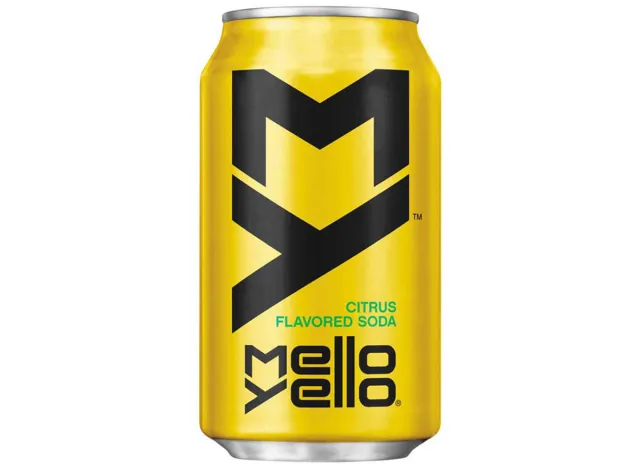
Despite its obvious health defects, Pepsi’s Mountain Dew captured Americans’ hearts from the beginning and quickly became one of the top-selling soda brands in the country. This success is what spurred Coca-Cola to invent its own recreation of the drink, which it dubbed Mello Yello.
Not surprisingly, Coke’s neon yellow soda shares many of the same attributes as Mountain Dew, and is just as hazardous. Mello Yello also gets its coloring from Yellow 5 and packs 290 calories in a 20-ounce bottle. It further contains 78 grams of added sugar—that’s over 150% of your daily intake recommendation.
Mello Yello additionally has a high level of caffeine, at about 85 milligrams per 20-ounce bottle, which will have you feeling anything but mellow.
To achieve its Zero Sugar variation, the brand uses artificial sweeteners including aspartame. This is one of the more popular sugar swaps in various foods and beverages and is actually 200 times sweeter than sucrose. But, a 2022 NutriNet-Santé cohort study found that people who consumed higher levels of the substitute were more likely to develop cancer overall and particularly breast and obesity-related cancers.
For different reasons, both Mello Yello and its Zero Sugar companion have been harder to find as of late–which, for our health’s sake, may just be for the best.
Sun Drop
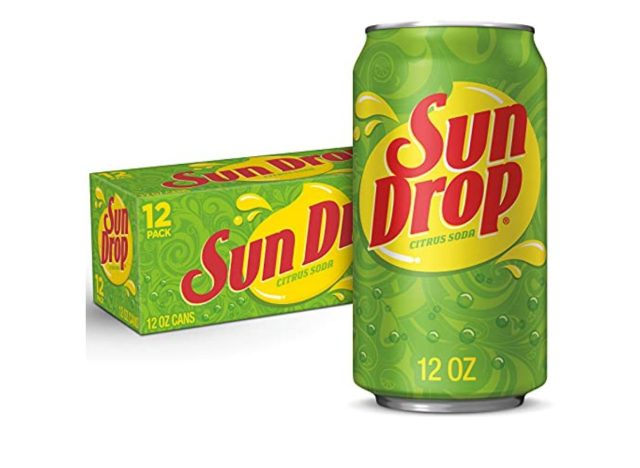
Of course, Keurig Dr. Pepper also holds a seat at the citrus-flavored soda table with its own rendition called Sun Drop. In fact, it’s actually older than both Mello Yello and Mountain Dew, with roots dating back to the late 1920s, according to Southern Living.
Sun Drop matches both Mountain Dew and Mello Yello in terms of total calories and has just a little less sugar. The soda also contains additives like high fructose corn syrup and Yellow 5, and actually blows the other two brands out of the water when it comes to caffeine content, with 106 milligrams in every 20-ounce bottle.
But, what’s most concerning, is that while both Coke and Pepsi have backed off from using BVO in their soft drinks, Sun Drop still contains the additive. It’s mixed into the beverage because it helps to keep citrus flavors from separating out. But, it’s been found that bromine–a main ingredient in BVO–can irritate your skin and other mucous membranes, and extended use can even lead to symptoms like headaches, impaired balance, or memory loss, according to Middlesex Health.
On top of that, drops of sodium benzoate and something called ester gum—an oil-soluble food additive that comes from refined wood rosin and food-grade glycerol–can also be found in Sun Drop.
Pepsi
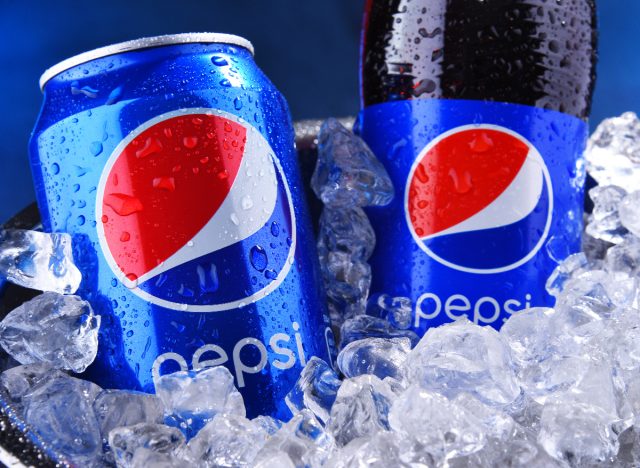
Pepsi and its arch nemesis Coca-Cola have always gone head-to-head, or can-to-can, constantly duking it out. But, there are a couple nutritional categories where Coke currently has Pepsi edged out by just a hair. Each 20-ounce Pepsi bottle contains a smidge more sugar—69 grams compared to Coke’s 65. It has a few more calories, too: 250 calories compared to 240 for Coke.
Pepsi also contains more caffeine overall—that’s great for those looking for a little extra umph, but not so great for your body in the long run.
The rivals also share a nearly identical ingredient list, with one important exception: Pepsi contains citric acid while Coke does not. Citric acid is naturally occurring in citrus fruits like lemons. But, the kind which is typically found in packaged foods for preservative purposes is known as manufactured citric acid, and comes from an unsavory source: black mold. The FDA has classified this additive as “generally recognized as safe” for consumption—but still something to think about next time you pop the tab on that Pepsi can.
High fructose corn syrup and caramel coloring are also key players on Pepsi’s ingredient list. In high doses, caramel coloring has been found to be carcinogenic. And, as for high fructose corn syrup, there are a myriad of possible negative side effects. The artificial sugar has been linked to diabetes and heart disease. It also increases your risk for weight gain, and experts widely believe that high fructose corn syrup is a major contributor to the obesity epidemic.
Dr. Pepper
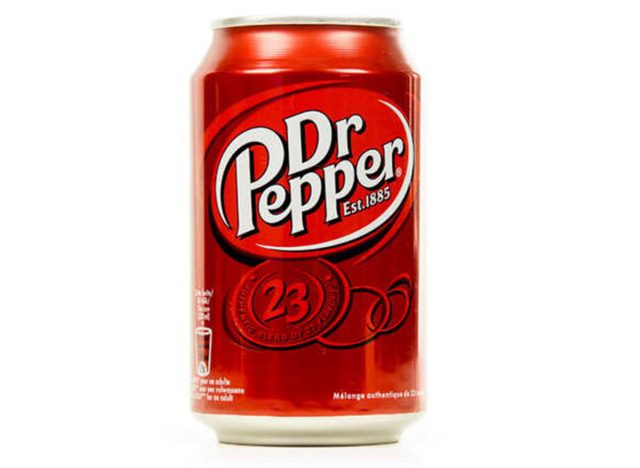
This is certainly not what the doctor ordered. Dr. Pepper commonly boasts its 23 special flavors including almond, caramel, blackberry, vanilla, nutmeg, and even things like carrot and tomato, making the drink sound like a rejuvenating medley of fresh ingredients. But, the reality is, most of these tastes are not authentic, and are instead cooked up in a lab.
Similar to other top soda brands Coke and Pepsi, Dr. Pepper’s actual ingredient list consists of high fructose corn syrup and caramel coloring. This coloring agent is, again, used for nothing other than aesthetics. But, it has been linked to hypertension, liver damage, and reduced white blood cell counts.
The doctor doses out another secret ingredient as well: phosphoric acid. This compound gives Dr. Pepper its tartness. But, it’s important to note that this ingredient is also commonly used in fertilizers, detergents, and other cleaning supplies.
Besides just sounding unappetizing, phosphoric acid has also been shown to have a negative affect on your kidneys and puts you at higher risk for heart disease, decreased bone density, and even osteoporosis. This is particularly a concern for women—a group that may already have mixed feelings toward the Dr. Pepper brand after the company’s “It’s not for women” campaign back in 2011. The campaign was meant to loop more men into the diet soda market, with a new 10-calorie Dr. Pepper. But, you can likely see why it wasn’t well received.
Mug Cream Soda
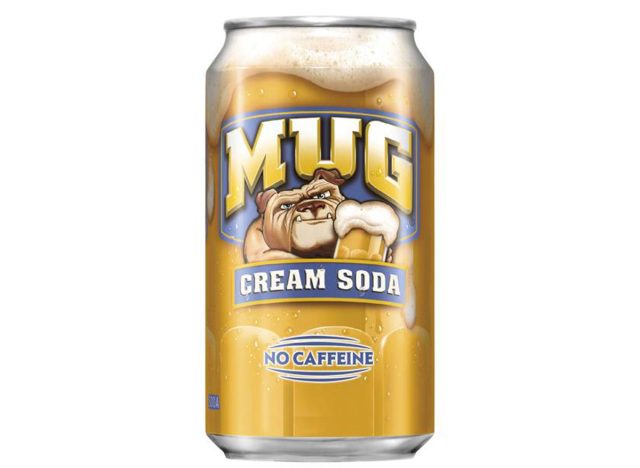
Cream soda is like the dessert of all soft drinks. And fittingly, it contains just as many, if not more, calories and sugar than many of the sweets you’d find on the market.
Mug’s own velvety version specifically contains 290 calories, 105 mg of sodium (the same as Mountain Dew), and 79 grams of sugar per 20-ounce bottle. That level of sugar is equivalent to eating almost three whole Snickers bars or an entire large hot fudge sundae from Dairy Queen.
A dangerous trifecta of sodium benzoate, high fructose corn syrup, and caramel coloring is also included in Mug Cream Soda’s chemical makeup. Not to mention something called yucca mohave extract makes the list. This is a plant extract which is commonly used in cosmetics and as an animal feed additive. Yucca has been given the thumbs up by the FDA, suggesting it’s safe for consumption. But it certainly sounds “yuccy,” doesn’t it?
And, Mug Root Beer–the brand’s other popular product line–isn’t much better. The root beer contains many of these same ingredients as its cream soda cousin, but does have a slightly lower calorie and sugar count.
Sunkist
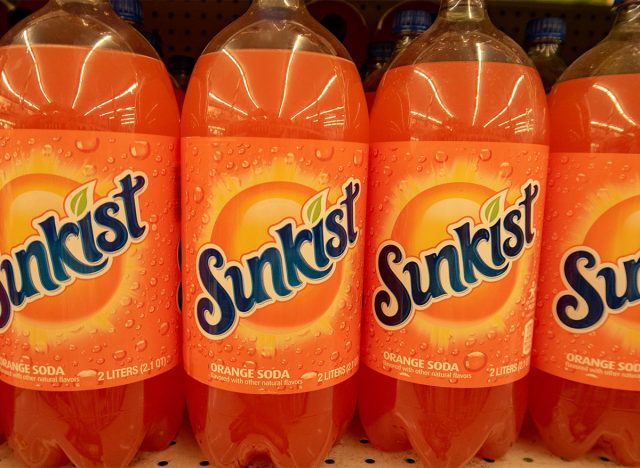
Sunkist’s bright packaging with dew droplets and pictures of juicy oranges may trick you into believing the drink is made from fresh fruit and therefore can’t be that bad. But, that couldn’t be farther from the truth. Orange sodas like Sunkist are actually one of the worst soft drink flavors you can pick for the reasons we’re about to disclose.
A quick peek at the Sunkist label reveals that the word “orange” is nowhere to be found. And, with no real oranges to give it that neon orange coloring something else must be at play. Well, that would be a combination of Yellow 6 and Red 40–both chemical dyes which are highly controversial.
And, in Sunkist’s other fruity flavors, there’s more of the same. To achieve the purple coloring of the brand’s grapeless Grape flavor, Red 40 and Blue 1 are thrown together. Red 40 and yellow 5 work together to create Peach, and Cherry Limeade is made from Red 40 and Yellow 5. You get the idea.
In all variations you will also find high fructose corn syrup, citric acid, and sodium benzoate as well. And while all flavors are, without a doubt, unhealthy, the top two worst flavors the brand offers are Fruit Punch and Pineapple due to their ridiculously inflated sugar content. Sunkist Pineapple holds 84 grams of sugar and Sunkist Fruit Punch stands at 80 grams–putting the drinks 320 and 300 calories per 20-ounce bottle, respectively.
Crush
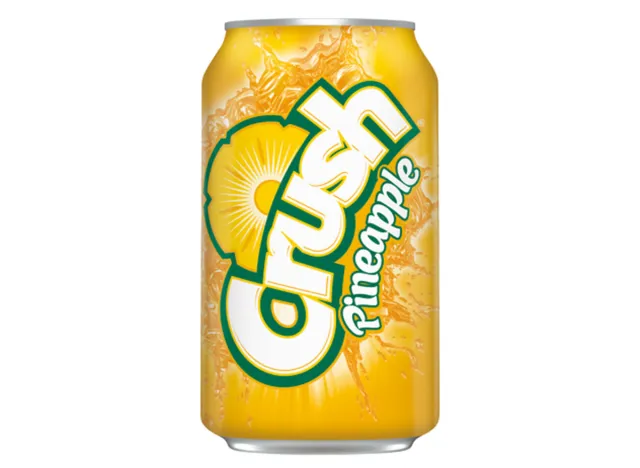
Crush got its start as an orange soda—and you already know the problems associated with those including food dyes and a lack of any kind of nutritional value. But, where the brand really went off the deep end is with its pineapple flavor, which is one of the most high-calorie and sugar-filled sodas on the market.
Just like Sunkist’s pineapple-flavored soda, the Crush version also has a stomach-churning 320 calories. But, it surpasses the Sunkist version with a total of 85 grams of sugar. That’s 169% of your daily recommended amount.
The usual suspects appear on Crush soda’s nutrition labels including high fructose corn syrup and sodium benzoate. Plus, Crush Zero Sugar Orange comes with a few extra surprises like malic acid, the preservative potassium benzoate, aspartame, sodium citrate, and acesulfame potassium. To call it a science experiment wouldn’t be too far off.
- Source: https://pubmed.ncbi.nlm.nih.gov/25750299/
- Source: https://pubmed.ncbi.nlm.nih.gov/25750299/
- Source: https://health.clevelandclinic.org/mountain-dew-mouth/
- Source: https://pubmed.ncbi.nlm.nih.gov/35324894/
- Source: https://www.ncbi.nlm.nih.gov/pmc/articles/PMC6097542/
- Source: https://www.chemicalsafetyfacts.org/chemicals/citric-acid/
- Source: https://www.cspinet.org/article/caramel-coloring
- Source: https://www.ncbi.nlm.nih.gov/pmc/articles/PMC4721164/
- Source: https://www.ncbi.nlm.nih.gov/pmc/articles/PMC7071508/
- Source: https://www.drugs.com/npp/yucca.html









